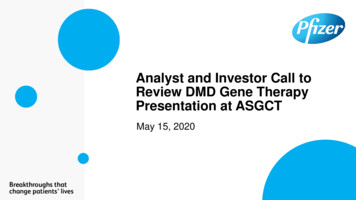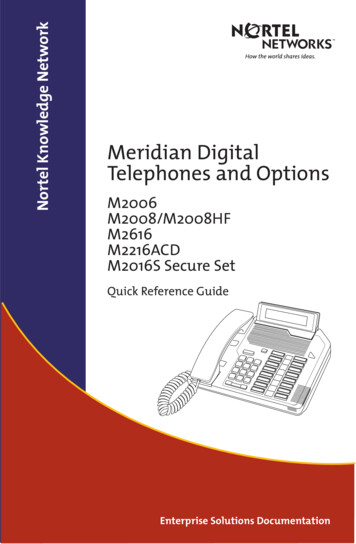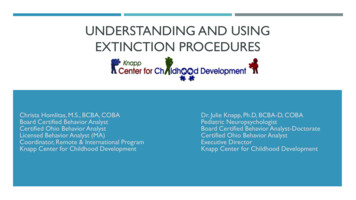
Transcription
Analyst and Investor Call toReview DMD Gene TherapyPresentation at ASGCTMay 15, 20201Property of Pfizer. Not for Distribution.
DisclaimerThis presentation includes forward-looking statements about, among other things, development of Pfizer’s RareDisease products and product candidates, including our investigational mini-dystrophin gene therapy (PF-06939926), apotential Phase 3 study, our manufacturing capabilities and capacity, and their potential benefits, that are subject tosubstantial risks and uncertainties that could cause actual results to differ materially from those expressed or implied bysuch statements. These statements are subject to risks, uncertainties and other factors that may cause actual results todiffer materially from past results, future plans and projected future results.Additional information regarding these factors can be found in Pfizer’s Annual Report on Form 10-K for the fiscal yearended December 31, 2019 and in our subsequent reports on Form 10-Q, including in the sections thereof captioned“Risk Factors” and “Forward-Looking Information and Factors that May Affect Future Results,” as well as in oursubsequent reports on Form 8-K, all of which are filed with the US Securities and Exchange Commission (SEC) andavailable at www.sec.gov and www.pfizer.com.The forward-looking statements in this presentation speak only as of the original date of this presentation, and weundertake no obligation to update or revise any of these statements.2Property of Pfizer. Not for Distribution.
IntroductionMikael Dolsten, M.D., Ph.D.Chief Scientific Officer and President, WorldwideResearch, Development, and Medical, Pfizer3Property of Pfizer. Not for Distribution.
Duchenne Muscular Dystrophy Hereditary severe X-linked musculardystrophy incidence 1:3500-5000 / male live births absent functional dystrophin proteinreduces structural integrity of musclefibers Delays in motor milestones diagnosis at 2-5 years of age sometimes cognitive impairment Loss of ambulation Progressive cardiac and respiratoryfailure4Property of Pfizer. Not for Distribution.
Study Design for Phase 3 Expected to Begin Dosing in 2H 2020 A Phase 3, global, multicenter, randomized, double-blind, placebo-controlled study to evaluate thesafety and efficacy of PF-06939926 in ambulatory male patients with DMD Eligible patients will be randomized into 2 groups: either Cohort 1 or Cohort 2 in a 2:1 ratioBASELINESCREENINGMAINSTUDYPF-06939926Cohort 1669933Cohort 212MonthsPlaceboELIGIBILITY ASSESSMENT FORYEAR 2 IP ADMINISTRATION All patients will be followed for 5 years after treatment with investigational gene therapy ebo3Years12Months4YearsPF-069399265Property of Pfizer. Not for Distribution.
A Leading Rare Disease Pipeline With 6 New Molecular Entities Expected tobe in Phase 3 Studies by 2H 2020In linePhase 3Phase 1 & 2Pre-ClinicalGene Therapy (GTx)Property of Pfizer. Not for Distribution.6
Significant Investment in Gene Therapy Manufacturing of Viral Vectors toSupport Rapid Drug Development and AccessLeader in the Manufacture of AAV Vectors usingMammalian Cells: Three manufacturing facilities ( 300,000 sq ft)designed to support DMD and multiple other genetherapy programs in parallel, depending on dose andproduct mix, by 2022; built for growthKit Creek, NCDurham, NC Internal end-to-end gene therapy manufacturingcapabilities across research-developmentcommercial axis to support rapid accessSanford, NC7Property of Pfizer. Not for Distribution.
Safety and Tolerability of PF-06939926 inAmbulatory Boys with Duchenne MuscularDystrophyTara McDonnell Moorehead, Florence Yong, Srividya Neelakantan, Katherine Beaverson,David Beidler, Michael BinksMichael Binks, M.D.Vice President, Rare Disease Clinical Research8Property of Pfizer. Not for Distribution.
Developing a Gene Therapy for DMD PF-06939926 is an AAV9 gene therapy vector containing a miniaturizeddystrophin transgene Includes a muscle specific promoter to preferentially express in skeletal andcardiac muscle cells Contains 3978 mini-dystrophin transgene Clear dose response on Ratmdx cardiac and skeletal muscle transduction withimproved skeletal muscle strength and echo parameters Triple transfection suspension mammalian cell line manufacture9Property of Pfizer. Not for Distribution.
C3391001 (NCT03362502) Design: Ongoing Phase 1b StudyBaseline MuscleBiopsyNSAAMonth 12BiopsyMonth 2 MuscleBiopsySafety through 12 monthsNSAAThigh MRIPRIMARY ENDPOINTThigh MRISECONDARY ENDPOINTSDystrophin concentration and distributionPF-06939926 Cohort 1: 1E14 vg/kg(N 3-6) Safety Review Cohort 2: 3E14 vg/kg(N approx. 6-10)Long-term safety (5 years)Treatment Follow-up(12 months)Long-term Follow-up(4 years)Primary Analysis:Safety Single intravenous (IV) infusionwith staggered dosingOTHER ENDPOINTSFunctional Assessments (NSAA )BiomarkersMRI ImagingImmune ResponseViral SheddingClinical Outcomes AssessmentsActivity Monitoring10Property of Pfizer. Not for Distribution.
C3391001 Study and Safety Status (as of 20th March 2020*)Phase 1b Study Status 3 Sites in US 9 Participants with DMD Enrolled: Ambulant and on daily glucocorticoids (GC) Age mean: 8.8 years (range: 6.2-12.8 years old) Body weight mean: 27 kg (range: 18-42 kg) Rise from floor mean: 4 sec (range: 3-7 sec) Negative for neutralizing antibodies (NAb) to AAV9 and antidystrophin T-cell response 10% excluded due to NAb positive test at screening 9 Participants Dosed: 3 at 1E14 vg/kg 6 at 3E14 vg/kg* 3 additional patients have been dosed since March 20, 2020. No SAEs andno new safety signals have been observed in these patients to date.11Property of Pfizer. Not for Distribution.
C3391001 Study and Safety Status (as of 20th March 2020*)Phase 1b Study StatusPreliminary Safety Summary 3 Sites in US PF-06939926 intravenous (IV) administration well tolerated 9 Participants with DMD Enrolled: No evidence of hepatic dysfunction or clinically relevantanti-dystrophin response with daily GC regimen Adverse events occurring in 40% of participants (in order): Ambulant and on daily glucocorticoids (GC) Age mean: 8.8 years (range: 6.2-12.8 years old) Body weight mean: 27 kg (range: 18-42 kg) Rise from floor mean: 4 sec (range: 3-7 sec) Negative for neutralizing antibodies (NAb) to AAV9 and antidystrophin T-cell response 3 serious adverse events (SAEs) Persistent vomiting resulting in dehydration (requiredadmission for IV anti-emetics and fluids) Acute kidney injury with atypical hemolytic uremicsyndrome (aHUS)-like complement activation (requiredhemodialysis and eculizumab) Thrombocytopenia with aHUS-like complement activation(required platelet transfusion and eculizumab) 10% excluded due to NAb positive test at screening 9 Participants Dosed: 3 at 1E14 vg/kg 6 at 3E14 vg/kg* 3 additional patients have been dosed since March 20, 2020. No SAEs andno new safety signals have been observed in these patients to date.Vomiting, nausea, decreased appetite, pyrexiaMonitoring and management regimen amended in protocol tomitigate risk12Property of Pfizer. Not for Distribution.
Concentration of Dystrophin in Muscle Biopsy by LCMSNovel LC-MS Assay: immunoaffinity liquid chromatographytandem mass spectrometry (IA LC-MS/MS)High sensitivity andreproducibilityWide dynamic rangeGLP Quality20 biopsies each from:DMD patients (mean age 6yrs)BMD patients (mean 8yrs)Non-dystrophic,pediatric control group(mean 10yrs)Clear distinction in expressionlevels between DMD and BMD13Property of Pfizer. Not for Distribution.
Concentration of Dystrophin in Muscle Biopsy by LCMSSignificant and Sustained expression at 12 monthsNovel LC-MS Assay: immunoaffinity liquid chromatographytandem mass spectrometry (IA LC-MS/MS)3E14 vg/kg1E14 vg/kgHigh sensitivity andreproducibilityMean SEM based on dataavailable at each scheduled visitWide dynamic range**Significant difference betweenbaseline and post-treatment:Month 2 (N 9): p 0.005Month 12 (N 6): p 0.05GLP Quality20 biopsies each from:*DMD (mean age 6yrs)BMD patients (mean 8yrs)Non-dystrophic, pediatriccontrols(mean 10yrs)Clear distinction inexpression levels betweenDMD and BMD**N 33366314Property of Pfizer. Not for Distribution.
Significant and Sustained Distribution of Dystrophin in Muscle Biopsy byImmunofluorescence3E14 vg/kg1E14 vg/kgMean SEM based on dataavailable at each scheduled visit*Immunofluorescence Images for 3 High Dose Patients*Red Dystrophin/mini-dystrophinexpression**3E14 vg/kg Dose: Mean %positive fibers 53% at 2 months (N 6).At 12 months, Mean increased from 48% to 51% (N 3).N 333663NOTE: All images acquired using an updated digital platformand analysis with a new quantitative imaging algorithm*Significant difference between baseline and post-treatment: Month 2 (N 9): p 0.005 Month 12 (N 6): p 0.0515Property of Pfizer. Not for Distribution.
NSAA Total Scores Show Improvement 12 Months After TreatmentRelative to Natural History and Clinical Trial Placebo GroupsUK NorthStar Natural HistoryExternal Placebo (PBO) Control*95% Bootstrap CIGTx meanobservationsCohort 1 IndividualCohortabovethe1 MeanupperCohort 2 IndividualCohortlimit ofthe2 Mean95% CIChange from BaselineBootstrap Distribution of the Mean Change from Baseline to 1-yearPost Randomizationp 0.01*N 3p 0.0001* 7.5 points*Empirical p-values estimated byMonte Carlo proceduresBackground (N 395) from Figure 1 of Muntoni et al. (2019)PLoS ONE 14(9): e0221097. (cTAP consortium)*External PBO (N 61) constructed from PBO of PFE domagrozumab studyand PBO of another study in TransCelerate PSoC DB (N 142) matchingkey eligibility criteria (age, weight, function) of C3391001 study.Black bars (right panel): 95% bootstrap confidence interval (CI) for themeanExternalPBO(N 61)1E14 vg/kgCohort 13E14 vg/kgCohort 2PF-06939926Significant difference between External Placebo (N 61) and PF-06939926 study (N 6): median -4 vs 3.5, p 0.00316Property of Pfizer. Not for Distribution.
Whole Thigh MRI – Significant Reduction in Fat Fraction at 12 monthsIdentical Dixon Method Applied to Both Studiesa.b.c.MR scans acquired without compressing thigh tissue.Whole thigh were segmented to identify muscle and fat.Mean Dixon fat fraction computed over all voxels in entire segmented muscle.MRI Fat Fraction Map of 1 Subject in High DoseWEEK 52MRI Fat Fraction (% Change from Baseline)Relative to Recent Clinical Trial Placebo group (Domagrozumab)Improvement in whole thigh fatfractionNS*N 3N 3p 0.0001*ExternalPBO(N 10)1E14 vg/kgCohort 13E14 vg/kgCohort 2PF-06939926External PBO: PFE domagrozumab study placebo group matching key eligibilitycriteria (age, weight, function) of C3391001 study10%Black Bars: 95% bootstrap confidence interval for the Mean %Change*Empirical p-values estimated by Monte Carlo procedures: NS Not Significant17Property of Pfizer. Not for Distribution.
Conclusions Preliminary results from the ongoing C3391001 Phase 1b study (NCT03362502) are encouraging For current Cohort 2 (PF-06939926 at 3E14 vg/kg ITR Dose) PF-06939926 infusion well-tolerated, but complement activation 5-10 days associated with aHUS-like phenomenao Increased monitoring and intervention regimen supports continued development at current dose level Significant and sustained expression of mini-dystrophin in biceps muscle biopsy Mini-dystrophin concentration at levels expected to translate into potential clinical benefit Trend towards increased concentration between 2 and 12 months No loss of mini-dystrophin expressing muscle fibers at 12 months NSAA : Mean improvement in motor function score at 12 months exceeds expectations (given age and baselinefunction) by 6 points Thigh MRI Fat Fraction: Improvements at 12 months never observed in matched placebo control population Global Phase 3 randomized, multicentre, double-blind, placebo-controlled study is on track to start 2H2020pending regulatory approval Sample size 99, sites will become active on a rolling basis, starting in the United States C3391003 study is registered on ClinicalTrials.gov (NCT04281485) Process for commercial manufacturing at 2,000 L scale was initiated in 201918Property of Pfizer. Not for Distribution.
AcknowledgmentsWe extend our heartfelt ‘thank you’ to all the study participants, their families, researchers, investigators, otherclinicians and advocacy organizations for their passion, expertise and engagement, helping to advance clinicalresearch and care for the Duchenne muscular dystrophy community.Special acknowledgements to: Study participants and their families Study investigators: Russell J. Butterfield, MD, PhD Perry B. Shieh, MD, PhD Edward C. Smith, MD TransCelerate PSoC Data Sharing Initiative*Expert Clinicians fromUS and Europe*The external control data was based in part on data from the TransCelerate BioPharma Inc. Placebo and Standard of Care (PSoC) Data Sharing Initiative, which includes contributions ofanonymized or pseudonymized data from TransCelerate PSoC member companies including Abbvie, Allergan, Amgen, AstraZeneca, Astellas, Bristol-Myers Squibb, Boehringer Ingelheim,Eli Lilly, GlaxoSmithKline, Johnson & Johnson, EMD Serono, NovoNordisk, Pfizer, Roche, Sanofi, Shionogi, and UCB Pharma (“Data /Disclaimer: Neither TransCelerate Biopharma Inc. nor the Data Providers have contributed to or approved or are in any way responsible for Pfizer’s research results19Property of Pfizer. Not for Distribution.
Mikael Dolsten – Chief Scientific Officer and President, Pfizer WorldwideResearch, Development, and MedicalQ&ASeng Cheng – Chief Scientific Officer and Senior Vice President, Rare DiseaseBob Smith – Senior Vice President, Global Gene Therapy, Rare DiseaseBusiness UnitMichael Binks – Vice President, Rare Disease Clinical Research20Property of Pfizer. Not for Distribution.
Monitoring and management regimen amended in protocol to mitigate risk. Phase 1b Study Status. Preliminary Safety Summary. C3391001 Study and Safety Status (as of 20th March 2020*) 3 Sites in US 9 Participants with DMD Enrolled: Ambulant and on daily glucocorticoids (GC) Age mean: 8.8 years (range: 6.2-12.8 years old) Body weight .











